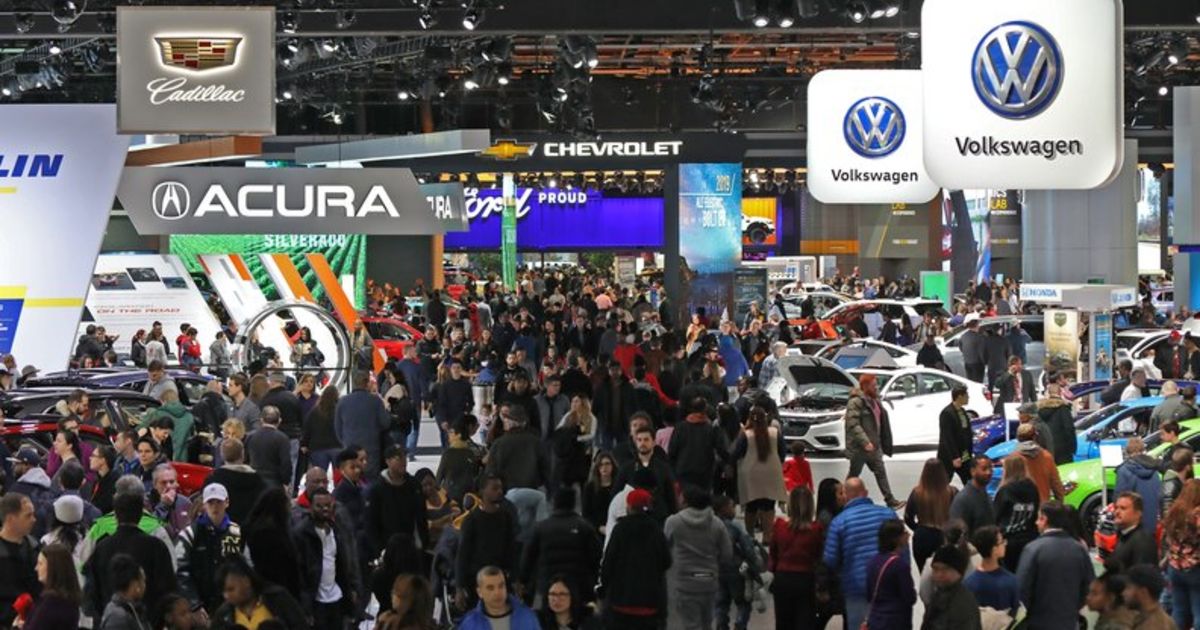
This is not going to be your father’s Detroit auto show, nor is it going to be your grandfather’s auto show.
Apologies for any misapplied generational assumptions, but you get the gist. The long-awaited return of the Detroit auto show — with a painfully convoluted new name — is sadly nothing like the sometimes awe-inspiring North American International Auto Show events from 1989 to (generously) 2019.
Nor is 2022 a return to the semicomic/semitragic, fully sexist past, when pretty women in skimpy attire lured attendees to display stands hoping their distracted brains would associate the brand or vehicle with the good feelings they had about the talent on stage.
This year’s North American International Detroit Auto Show, like its peers around the world, is now a regional event — designed for consumers to come see lots of cars and make them want to buy these cars and feel good about it all.
Once again and for the record, I am sad about this. The auto shows I built my career covering were international gatherings of potentially epic consequences. Executives and journalists from the entire automotive world would convene a half dozen or so times a year. Anything could happen.
Like the Ram and Chevy Silverado reveals of 2018, competing vehicles were unveiled the same day. That year, I remember walking up to Jim Morrison, then head of Ram. Wearing a big smile, he shook my hand and asked: “Did you go look at the Silverado?” He had a winner, and he knew it.
Back at the emergence of once-iconic NAIAS in 1989, Toyota and Nissan came to Detroit to introduce their entries into the luxury market, alongside Lexus and Infiniti. Talk about an intercontinental throwdown!
Thousands and thousands of journalists came from all over the world. Volkswagen, I’m told, would bring a planeload of scribes to document its activities. That might sound silly, in light of the brand’s relatively pathetic U.S. market share, but it wasn’t all about U.S. sales as much as it was about global stature. That’s really what these international auto shows were all about.
Last week’s Jeep and Chevy reveals reflect the changing nature of new-vehicle introductions: Instead of pulling sheets off new sheet metal in a series of press conferences, brands now tend to prefer the better video quality and worldwide distribution of online reveals or TV spots.
This leaves the regional auto show as the one place where consumers can go to see cars — or electric crossover vehicles — in person.
The Detroit auto show is adjusting. With only three brands planning press conferences — and only five automakers sponsoring floor space in Huntington Place (nee Cobo Hall) — politicians may be a bigger draw for journalists than any vehicles or executives on hand.
The emphasis now, from Detroit to Tokyo to, I guess, Hamburg, is on the public days, with fun activities for kids of all ages. In Detroit, folks can see models of dinosaurs and the car from the 1994 “Flintstones” movie. They can ride on SUVs that almost scrape the roof and, of course, a giant rubber ducky.
As I’ve said before, the beginning of the end of the truly global auto show was 2016, when GM decided to reveal the Chevy Bolt at CES, the week before Detroit, then hosted a technical briefing on the electric vehicle in the Motor City. That was also the year Ford CEO Mark Fields was itching to announce a deal to make the Google car. When one couldn’t be reached in time, he was left on stage at Cobo Hall hyping the promise of having a cappuccino coupon delivered to your car that was tracking everything you do.
The press saw through both ruses. Detroit was dead, and all of the other once-international auto shows faded into global irrelevance.
In 2016, NAIAS had four major brands — Acura, Lincoln, GMC and Nissan — holding press conferences on the second morning of the show, before the splinter-group meetings with analysts and, of course, the Automotive News World Congress. That compares with three press conferences on the one media day of this year’s show.
The floor maps tell the tale just as objectively. Brands used to jockey for space, and show organizers would have to allocate floor space by market share to demonstrate its fairness. Now a startup called Harbinger, offering electric-powered chassis cabs, may have as much square footage at Huntington Place as Lincoln does.
Correct me if I’m wrong, but at this point, the preeminent global auto show — the only place one might see automaker CEOs from multiple continents — is now CES in Las Vegas.
Some of us, especially journalists like me, prefer the way it was before the pandemic and before automakers started doubting the benefits of spending millions of dollars on flashy reveals and global gatherings of executives, journalists and so many others who make up this amazing industry.
But we all must live in the world as it exists today — meaning resegregated markets, newfound budget discipline amid record profits and a new focus on the consumer experience — even as vehicles become ever more out of reach to the average consumer.
At least they can go see some in person, like a flying motorbike and a big rubber duck.